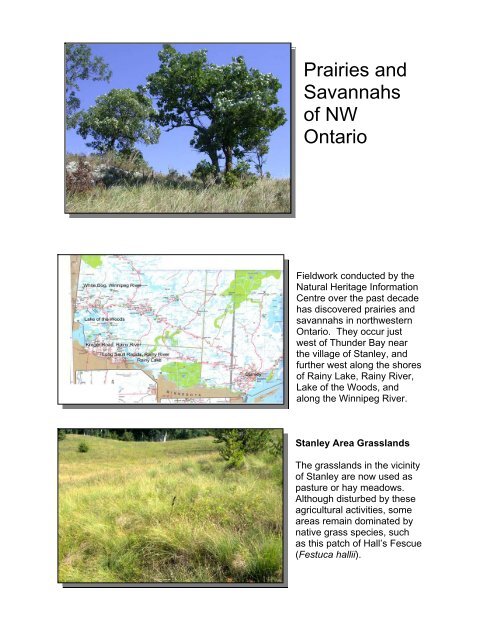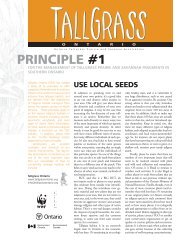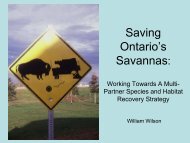Prairies and Savannahs of NW Ontario - Tallgrass Ontario
Prairies and Savannahs of NW Ontario - Tallgrass Ontario
Prairies and Savannahs of NW Ontario - Tallgrass Ontario
You also want an ePaper? Increase the reach of your titles
YUMPU automatically turns print PDFs into web optimized ePapers that Google loves.
Original L<strong>and</strong> Survey <strong>of</strong>Paipoonge Township, StanleyArea. Conducted by T.W.Herrick, P.L.S, 1856, FieldNotebook #1572.This section shows the flat s<strong>and</strong>yterrace north <strong>of</strong> the KaministiquiaRiver, dominated by “S<strong>and</strong>yPlain <strong>and</strong> no Bush”, interruptedonly by the stream <strong>and</strong> creekvalleys which dissect this plain.Map showing the originalextent <strong>of</strong> grassl<strong>and</strong> in theStanley area, based on theoriginal l<strong>and</strong> survey notes<strong>of</strong> 1856. According to thesurvey notes, the entiregently rolling s<strong>and</strong>y plainnorth <strong>of</strong> the river to thenorthern townshipboundary was open s<strong>and</strong>yplain, interrupted by thicketvegetation along thestream <strong>and</strong> creek valleys.Through aerial photointerpretation, the extent <strong>of</strong>the s<strong>and</strong>y plain can bemapped. Approximately 16km 2 <strong>of</strong> this grassl<strong>and</strong>occurred in this area.
The compressed stem <strong>of</strong>Drummond’s Thistle aprovincially rare species onlyfound in <strong>Ontario</strong> in the vicinity <strong>of</strong>Stanley.Wild Heliotrope (Phacelia franklinii), aprovincially rare western speciesfound in the Stanley grassl<strong>and</strong>s, aswell as herbaceous meadowsassociated with steep slopes <strong>and</strong>talus <strong>of</strong> the nearby Nor-westermounts.
Hoary Puccoon(Lithospermumcanescens), found inthe grassl<strong>and</strong>s atStanley, as well asprairies <strong>and</strong> oaksavannahs <strong>of</strong>southwestern <strong>and</strong>northwestern <strong>Ontario</strong>.Long Sault MoundsThe burial mounds atLong Sault, along theRainy River west <strong>of</strong> FortFrancis, were built intallgrass prairie. The siteis now part <strong>of</strong> a FirstNation interpretivecentre, Kay-Nah-Chi-Wah-Nung. JohnMacoun referred to theprairies along this river inhis travels to the westmore than a century ago.The dense herbaceousvegetation <strong>of</strong> thetallgrass prairie at LongSault Mounds. The sitehas a long history <strong>of</strong>aboriginal burning, <strong>and</strong>was (<strong>and</strong> continues tobe) an important source<strong>of</strong> medicinal <strong>and</strong>ceremonial plants forFirst Nation peoples.
Open grownBur Oak(Quercusmacrocarpa)at Long SaultMounds.Big Bluestem (Andropogongerardii) is a characteristictallgrass species, found inboth southern <strong>and</strong>northwestern <strong>Ontario</strong> prairies.
Prairie June Grass (Koeleriamacrantha), was originally knownfrom northwestern <strong>Ontario</strong> at onlyone site, the Stanley areagrassl<strong>and</strong>. It has declined greatlyin the relict tallgrass prairies <strong>of</strong>southern <strong>Ontario</strong>, <strong>and</strong> is nowknown from fewer than a halfdozensites in that region, althoughit is still common in the oak <strong>and</strong>oak-pine savannahs at PineryProvincial Park. Fieldwork byNHIC biologists have found itcommon in the prairies at LongSault <strong>and</strong> Lake <strong>of</strong> the Woods.The fires which burn through the tallgrass prairie at Long Sault also burn into theadjacent Bur Oak woodl<strong>and</strong>, maintaining the characteristic open aspect <strong>of</strong>tallgrass savannah.
Small patches <strong>of</strong> openBur Oak woodl<strong>and</strong>similar to that found atLong Sault Moundsoccur on silty knollsscattered throughoutthe length <strong>of</strong> RainyRiverGround shot <strong>of</strong> thetallgrass prairie atLong Sault Mounds,showing a clump <strong>of</strong>Big Bluestem, GoldenAlex<strong>and</strong>ers (Ziziaaptera) <strong>and</strong> PurpleVetchling (Lathyrusvenosus).Closer view <strong>of</strong>groundlayervegetation at LongSault, with ShowyLadyslipper(Cypripediumreginae), SenecaSnakeroot (Polygalasenega) in flower.
Leiberg’s Panic Grass (Panicumleibergii var. leibergii), a prairie speciesfound at Long Sault Mounds. It alsooccurs at two other prairie sites insouthern <strong>Ontario</strong>, Walpole Isl<strong>and</strong> <strong>and</strong>the Mohawk Cemetery at Tyendinaga.Torrey’s Sedge (Carex torreyi), awestern species recentlydiscovered new to <strong>Ontario</strong>,occurs at Long Sault Mounds aswell as a few prairies along theshores <strong>of</strong> Lake-<strong>of</strong>-the-Woods.
Long-toothed Lake Sedge (Carexlaeviconica) is a characteristic species<strong>of</strong> prairie sloughs in the centralAmerican Midwest. It has recently beenfound at a few sites along Rainy River,including Long Sault Mounds, the town<strong>of</strong> Manitou Rapids, <strong>and</strong> the mouth <strong>of</strong> theLa Vallée River.Heavy Sedge (Carexgravida) is a prairiespecies recentlyrediscovered new to<strong>Ontario</strong>, where it wasfound at Long SaultMounds <strong>and</strong> the town <strong>of</strong>Manitou Rapids. Theonly prior <strong>Ontario</strong>collection was a turn <strong>of</strong>the century record byJohn Macoun fromWalkerville (now a part<strong>of</strong> Windsor) in EssexCounty.
Bur Oak savannah withNeedlegrass (Stipa spartea)understory, Budreau’s Point.Western Ragweed(Ambrosia psilostachya), arare native species <strong>of</strong>northwestern <strong>Ontario</strong>prairies, Kreger Road.Lake-<strong>of</strong>-the-WoodsThe prairies <strong>and</strong> oaksavannahs on the Lake-<strong>of</strong>the-Woodsshorelines arefloristically the richest ones innorthwest <strong>Ontario</strong>. The bestsites occur on base-rich<strong>and</strong>esitic bedrock,colloquially referred to asgreenstone.
A cottage built in arich Bur Oaksavannah, Lake-<strong>of</strong>the-Woods,anunfortunate l<strong>and</strong> usein this provinciallyrare habitat.Closeup <strong>of</strong> Bur Oakshowing acorns.Downy Arrow-wood(Viburnum recognitum), acommon understory shrub inOak <strong>Savannahs</strong> <strong>and</strong>Woodl<strong>and</strong>s in both southern<strong>and</strong> northwestern <strong>Ontario</strong>.
The attractive orange-red anthers <strong>of</strong>Side-Oats Grama (Boutelouacurtipendula), a provincially rare prairiespecies recently discovered new tonorthwestern <strong>Ontario</strong> at Lake-<strong>of</strong>-the-Woods. It is also present at a fewprairie <strong>and</strong> alvar sites in southern<strong>Ontario</strong>.Canada Wild-rye, anotherattractive grass <strong>of</strong> prairies <strong>and</strong>s<strong>and</strong> dunes in <strong>Ontario</strong>. It iscommon in prairies, dunes <strong>and</strong>beaches along the shore <strong>of</strong> Lake<strong>of</strong>-the-Woods.
Kalm’s Brome Grass (Bromuskalmii), yet another attractive grassfound in the prairies <strong>and</strong> oaksavannahs <strong>of</strong> Lake-<strong>of</strong>-the-Woods. Itis also found in southern <strong>Ontario</strong>prairies, savannahs, alvars, <strong>and</strong> inrocky calcareous forests <strong>and</strong>woodl<strong>and</strong>s.Western Wheat Grass (Elymussmithii) occurs as a native in thericher prairie <strong>and</strong> Oak <strong>Savannahs</strong>on Lake-<strong>of</strong>-the-Woods. It has adistinct glaucous (grey-waxy) hue tothe leaves <strong>and</strong> stem. Previouslythought to be adventive in <strong>Ontario</strong>,where it can be found growing inrailway ballast <strong>and</strong> rights-<strong>of</strong>-way, itis clearly native in the undisturbed<strong>and</strong> remote habitats on Lake-<strong>of</strong>-the-Woods.
Yellow Panic Grass (Panicumxanthophysum) is commonlyfound in prairies <strong>and</strong> Bur Oaksavannahs on Lake-<strong>of</strong>-the-Woods.This extremely boring-looking grass is Plains Muhly (Muhlenbergia cuspidata). In<strong>Ontario</strong> it is only known from Picture Rock Point, Outer Bay, Lake-<strong>of</strong>-the-Woods.
The long awns <strong>of</strong> the distinctiveNeedlegrass make it readily identifiablewhen in fruit.Smooth Beardtongue (Penstemongracilis) is a provincially rare speciescommon in the prairies <strong>of</strong> Lake-<strong>of</strong>-the-Woods.
Western SilverAster isconsidered tobe aThreatenedspecies in<strong>Ontario</strong>. Onlytwo sites areknown from theprovince, bothalong the shore<strong>of</strong> Lake-<strong>of</strong>-the-Woods. It wasformerly knownfrom Ingolf,<strong>Ontario</strong>, butrecent surveyshave failed t<strong>of</strong>ind it there.Prairie Sage (Artemisiafrigida) is a fragrant prairieherb occurring innorthwestern <strong>Ontario</strong>prairies, <strong>and</strong> also fromStanley <strong>and</strong> the Nor’Westercliff rims near Thunder Bay,<strong>Ontario</strong>.
Prairie Smoke(Geum triflorum), ashowy <strong>and</strong>conspicuous herbwell-known fromalvars in southern<strong>Ontario</strong>, hasrecently beenfound at a fewprairies in thevicinity <strong>of</strong> SiouxNarrows, Lake-<strong>of</strong>the-Woods.Narrow-leaved Goosefoot(Chenopodium pratericola),a native goosefoot found innorthwestern <strong>Ontario</strong>prairies <strong>and</strong> cliff sites.
Collomia (Collomialinearis), a westernspecies found in Lake<strong>of</strong>-the-Woodsprairies,<strong>and</strong> also in the Stanleyarea grassl<strong>and</strong>s.Fragile Prickly-Pear (Opuntiafragilis) is a nativecactus found onrocky outcrops inprairies <strong>and</strong> BurOak savannahs onRainy Lake <strong>and</strong>Lake-<strong>of</strong>-the-Woods.
Until recently, Purple PrairieClover (Dalea purpurea) wasthought to be extirpated from<strong>Ontario</strong>. It is known from asingle location in a Bur Oaksavannah along Echo BayRoad, near Lake-<strong>of</strong>-the-Woods.The long (> 1 mm)white setae (mossawns) <strong>of</strong> WesternSpikemoss(Selaginella densa)distinguish it from themore common RockSpikemoss(Selaginellarupestris). Bothspecies occur onrocky outrcrops innorthwestern <strong>Ontario</strong>prairies <strong>and</strong> oaksavannahs.
Mountain Woodsia(Woodsia oregana) is arare fern that isfrequently found on thebase-rich bedrockfound in some sections<strong>of</strong> Lake-<strong>of</strong>-the-Woodsshorelines. It occurs increvices <strong>and</strong> on rockoutcrops in prairies <strong>and</strong>bur oak savannahs, aswell as cliffs in thisregion.The lavenderinflorescences<strong>of</strong> Blue Hedgehyssop(Agastachefoeniculum) area characteristiccomponent <strong>of</strong>prairies <strong>and</strong> BurOak savannahsin northwestern<strong>Ontario</strong>.
On siteswith the richest bedrock, the interface between shoreline cliff <strong>and</strong> prairie is one <strong>of</strong>the most interesting habitats. These sites are particularly rich in terms <strong>of</strong> plantspecies, many <strong>of</strong> them tiny in stature. The whitish plant is Prairie Sage.In this closer view, in a little over a square foot, the following diminutive speciesappear: Rough Pennyroyal (Hedeoma hispidum), Northern Androsace(Androsace septentrionalis), Prairie Cinquefoil (Potentilla pensylvanica), BlueHedge-hyssop, Purple Harebell, Poverty Grass, <strong>and</strong> rosettes <strong>of</strong> Prairie Buttercup(Ranunculus rhomboideus).
The chestnut-red upper sheaths <strong>of</strong>Richardson’s Sedge (Carexrichardsonii) readily identify thisspecies in the spring when it’s inflower. Later in the summer it can beidentified vegetatively by it’s distinctly3-ranked splayed leaves, <strong>and</strong> theirbluish-green leaf colour. It is awestern species found in prairies <strong>and</strong>savannahs throughout <strong>Ontario</strong>. It isalso found in calcareous dunes,alvars <strong>and</strong> woodl<strong>and</strong>s.Field Sedge (Carex conoidea) isanother provincially rare westernspecies found in prairies <strong>and</strong> Bur Oaksavannahs along Lake-<strong>of</strong>-the-Woodsshorelines.
Winnipeg RiverThe Winnipeg River, which drains Lake-<strong>of</strong>-the-Woods into the Nelson Riverdrainage basin in Manitoba, also supports small local areas <strong>of</strong> prairie, <strong>and</strong> at onesite just west <strong>of</strong> the White Dog First Nation, a Bur Oak savannah, illustratedabove.Anotherview <strong>of</strong> theBur Oaksavannah,with a largepatch <strong>of</strong> BigBluestem intheforeground.
The attractive flowers <strong>of</strong> Nodding Onion (Allium stellatum), found along theWinnipeg River <strong>and</strong> other northwestern <strong>Ontario</strong> prairie <strong>and</strong> Bur Oak savannahsites.A local area <strong>of</strong> tallgrass prairie dominated by Big Bluestem along the WinnipegRiver, with Stiff Sunflower in the foreground. This site is located approximately100 m east <strong>of</strong> the Manitoba border on the Winnipeg River







